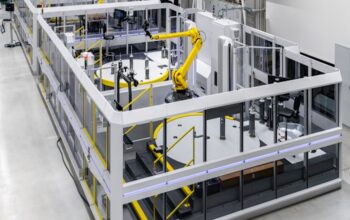Wind energy is a clean and pollution-free renewable energy source. Wind power stations are generally selected at the low places where mountains surround basins or ocean lakes, or through karst caves around mountains. However, wind power equipment is susceptible to environmental factors such as topography, landforms and seasons, hence strict quality control is indispensable.

The wind turbine hub plays a pivotal role from the perspective of structure, connecting the main shaft and blades. With the large-scale development trend of wind turbines, the load cycle of the hub can reach 10^9, and the design life can be as long as 20 years. Therefore, it is particularly important to strictly control the structural quality of the hub.
3D Inspection of Wind Turbine Hub
The wind turbine hub must have sufficient strength, rigidity and well shock absorption performance to reduce the load impact of the blades on the main shaft. However, the wheel castings are bulky, heavy tonnage, and complicated in manufacturing processes. How to accurately obtain 3D data for geometric tolerance testing?
3D Measurement Methods
The traditional measurement is extremely dependent on the operators’ experience, forming obvious disadvantages. With the continuous update of the technology, a handheld 3D laser scanner has come into all walks of life.
3D Laser Measurement:
- High accuracy & great detail
- Capture precise 3D data of complex surface easily
- Dynamic measurement
- Timesaving & labor-effective
Manual Measurement:
- Cumulative human errors
- Hard to inspect the complex surface
- Low efficiency & time-consuming

However, the normal handheld 3D laser scanners also have certain shortcomings to some extent. When confronted with a giant and heavy object, such as a wind turbine hub with a volume of 7m*5m*6m, the size is an insurmountable challenge, and the details are not satisfactory due to cumulative errors. Therefore, it is necessary to combine other products like photogrammetry equipment to avoid accumulated errors so as to obtain accurate 3D data.
Compared with the normal 3D laser scanners, KSCAN series 3D scanner not only has the portability and efficiency but also can perform ultra-high-precision full-scale 3D inspection. Its world’s first patented built-in photogrammetry technology conducts absolute performance on large-scale project measurements. KSCAN 3D scanner delivers metrology-grade measurement without the help of other inspection tools.
Step 1. Built-in photogrammetry system

Utilizing built-in photogrammetry system, we can get multiple 2D images of the hub, and calculate the 3D coordinate values of key points on the surface.
Step 2. 3D scanning

Through the 3D laser scanning function, the multiple laser beams can quickly obtain the 3D point cloud, and the workstation will display the 3D data in real-time.
Step 3. Complete 3D point cloud data


Step 4. Data comparison


KSCAN composite 3D scanner with a built-in photogrammetry system, can totally meet the requirements of high-precision 3D measurement to the maximum without extra equipment, truly realizing non-destructive testing. Meanwhile, its ultra-wide scanning area, depth of field and ultra-fast scanning rate greatly cut down the inspection time and shorten the product’s production cycle. Based on the test results, strict quality control can be carried out to create high-strength fatigue resistance.
To know more, check Scantech.









